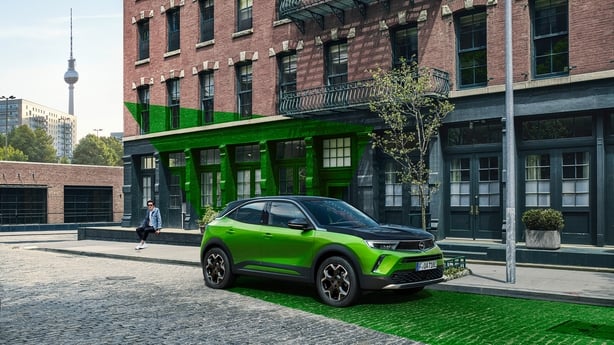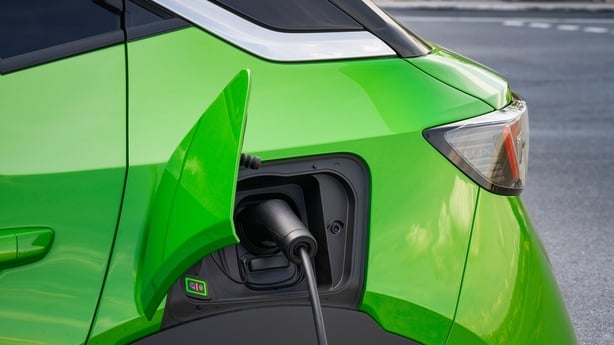We take to the road with the electric version of the car that won the Continental Tyres Irish Car of the Year small SUV award.
Opel deserves credit for having a deal more transparency about its claimed range on the electric version of its Mokka small SUV than other manufacturers have about their offerings. An easy to use range calculator is available for the car, with which you can make a calculation about how far you'll be able to drive at a given speed and with a given outside temperature.

The calculator tells you, for example, that if you are driving at the maximum legal motorway speed (120 kph) and with an outside temperature of 10 degrees, the claimed range of the car will drop from 341 km to 159 km.
Driving at 70 kph - with a temperature of 5 degrees - will deliver 304 km, according to the Opel calculator. You will notice how temperature, as well as speed, play an important role in determining how far an electric car will travel on one charge.
These are not factors you hear about in the advertising blurb put about by car manufacturers when the headline range figure is the one presumably achieved in the most ideal driving conditions and circumstances, although expensive Volkswagen ID models tend to nudge nearest to the claimed range figure. The short message here is not to accept the figure claimed by car companies without some serious questions.

Opel is not the only manufacturer whose car ranges are subject to several factors, including the above mentioned speeds, that have a significant impact on range. You have to add in other factors too - the use of a radio, electronic equipment, the heater, the demister, lights and so on.
I started one of my test drives in the Mokka at 09:00, with a temperature of 10 degrees, although it felt colder. I had charged the car overnight and now had full battery with a predicted range of 288 kilometres, and not the 341 indicated by Opel. My trip meter indicated I had done 184 km before the charge.
So, I set out for Athlone. I generally drove below the motorway speed limit of 120 kph (electric cars do have an energy conservation effect on one’s driving and I was driving in eco mode). When I arrived I had 333 km on the trip, meaning I had driven 149 km.
The dials indicated I had 22 per cent battery capacity and a range of 26 kilometres left. That’s the point at which you need to start looking around for a charge point and hope that you can find a fast one. Then figures meant I had gone from a full available range of 288 to 26 after only 149 kilometres.
On a city drive the Mokka came back closer to a comfortable range but it still managed to go from a 156 km range to an 82 km range after a round trip of about 26 kilometres. That’s a chunk of driving range. Cold weather was again a factor here.
Many electric cars I’ve driven have had the same pattern. At the moment I’m driving a car that seems to have lost 80 km of the supposed available range without much driving. Of course, there may be some variation between what the instruments are telling you and what the actual available range is before you run out of juice but I'm not that kind of risk taker, I'm afraid. I tend to work with the information I have rather than trying to challenge a theoretical set of figures.
Given that the Mokka is a city car it’s designed to for urban driving and, if you have a home charger, range should not be a huge issue for commuter runs. If you don’t have a home charger, then think very, very carefully about moving over to electricity in the currently deficient public charging network.
The Mokka sits tall, designed as it is as a small SUV and, while it lacks the presence of a Mini, its stying is both edgy and appealing. It comes in at a competitive 35,006 which, in the context of electric car pricing, is not at all bad for a car that looks like it has character.
Its also comfortable to drive and is ideally sized as a city car, although the sloping roofline does intrude on interior space in the rear. In fact, rear legroom is quite limited. The door sills are also high, making getting into the car a bit of a leg-lifting exercise.
When it comes to interior design in smaller electric cars, VW has the advantage over most others. A large screen and uncluttered dashboard give the ID models a very spacious feel, which is not the case with the Mokka. It has small screen with graphics that need an update and the satellite navigation on the version I drove was both fiddly and unpredictable.
Overall, however, the character the car displays on the outside is replicated on the inside. There’s a touch of performance about it and the smaller VW ID3 looks a tad conservative beside it.
The basic battery is a 50 kWh unit that Opel says will charge on a wall box in seven hours and 35 minutes, which will suit that urban driving routine. On a fast charger it will get from 25% to 80% in about 30 minutes.
Standard equipment is pretty comprehensive for this price point. You’ll get traffic sign recognition, lane assist, collision avoidance, a cyclist and pedestrian detector, LED lights all around, automatic cruise control and air conditioning, 17" alloys and an automatic high beam function.
As a city car the Mokka manages to make a statement for itself. With wall charging range anxiety shouldn’t be an issue unless you have to make frequent longer trips. If you do have to, then planning your charging map will be a requirement.
Like most initial electric car projects, the Mokka may well need to enter its second iteration before all the edges are smoothed out. It’s something that applies to almost all smaller electric cars at the moment. Car companies have all had to rush towards electric production to stay competitive and models are coming thick and fast. It’s a fast race and not without its issues.


